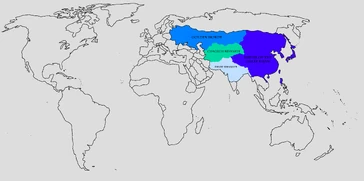
The Mongol Empire, including vassals and tributaries, at its height.
The Mongol Empire existed in the 13th and 14th centuries and was the largest contiguous empire in history. At its height it stretched from the Baltic Sea to the Sea of Japan, and from the frozen shores of Russland to the jungles of south-east Asia.
The Mongol Empire emerged from the unification of many Mongol and Turkic tribes under the leadership of Genghis Khan. Under the rule of he and his successors the empire grew rapidly, sending raids and invasions into settled lands in all directions. By connecting east and west it allowed the dissemination and exchange of trade, technologies, scholarship and ideologies all across Eurasia.
Invasion of Persia[]
Eastern Persia and much of adjacent Central Asia was under the rule of the Shansabanid Empire from modern-day Baktristan. By 1215 it had defeated the Khwarezmians, a Turkic confederation who had come from the north the previous century, and which was subsequently absorbed into the Mongol nation as the survivors fled east.
In 1218 Genghis Khan sent a trade mission to the city of Otrar on the banks of the Jaxartes. The governor of Otrar, fearing they may be spies, had the entire mission arrested and executed in public, and when Genghis sent an embassy to complain to the shah at Herat the ambassadors were killed as well. Desiring revenge, Genghis prepared his tumens for war.
The next year the Mongols besieging Otrar dealt a heavy defeat to the main Shansabanid army led by the shah himself. Over the next three years they stormed through Persia, sacking every city in their path, until by 1221 the Shansabanids were extinct in Iran and their remaining armies had either laid down their weapons or had fled.
Western Persia was at that time ruled by a branch of the Bagratuni dynasty, who had originated from Armenia. Their armies bolstered by fleeing Shansabanid troops, the Bagratunis started making shows of force on the border in the hope of provoking the Mongols into behaving rashly. At the time the Mongols did nothing, being occupied by their ongoing campaigns in China and Kievan Rus, but when in 1251 the Bagratunis actually attacked a Mongol patrol the Mongols retaliated with all their might.
After suffering several catastrophic defeats within a year, it looked like the Bagratids were about to go the same way as the Shansabanids. However, they had recently formed alliances with the Romans and with their cousins in Armenia and Georgia, and by the time of the decisive 1255 Siege of Arbela the allies had joined the Bagratunis to oppose the Mongols.
At this battle the Mongols won a tactical victory, but suffered so many losses that, when they heard of Roman reinforcements approaching, they abandoned their conquests and retreated to the previous frontier. The allies then marched to the Caucasus, where they defeated a second Mongol army under Batu Khan that had invaded Georgia from the north in the meantime, and then returned to their homelands to celebrate two great victories.
The Arbela campaign is noted for being the first ever defeat the Mongols had suffered that they were unable to avenge. From then on the Mongol Empire shrunk and fractured bit by bit, laying the foundation for the later Altai Confederation.
Invasion of Rus[]
Fragmentation[]
By the time Genghis' grandson Kublai became Great Khan in 1260, the Mongol Empire had fractured into four distinct parts, only nominally owing allegiance to Karakorum. The western steppes as far as the lands of the Rus were part of the Golden Horde, ruled by the descendants of Genghis' eldest son Jochi, and central Asia and eastern Persia were ruled by the descendants of his second son Chagatai. South Asia was part of the Delhi Khanate, while Mongolia itself, as well as China, Tibet and the whole east, constituted the remaining empire of the Great Khan.
The Golden Horde too fell apart over later generations, opening up a power vacuum into which the emerging powers of Lithuania and Novgorod could expand. Mongol rule in China, in the form of the Yuan Dynasty, ended in 1405 with the founding of the Ming Dynasty, and the remnants of the Yuan retreated to Mongolia where they returned to their nomadic ways.
The Chagatai Khanate, however, remained relatively unified, and only strengthened as Buddhism continued to spread amongst its people. In 1537 Dayan Khan conquered the Northern Yuan, throwing off Ming attempts to expand north and east, and he and his successors would gain, using a combination of war and diplomacy, many former Mongol states and beyond. He is generally considered to be the founder of the present-day confederation of Altai.
